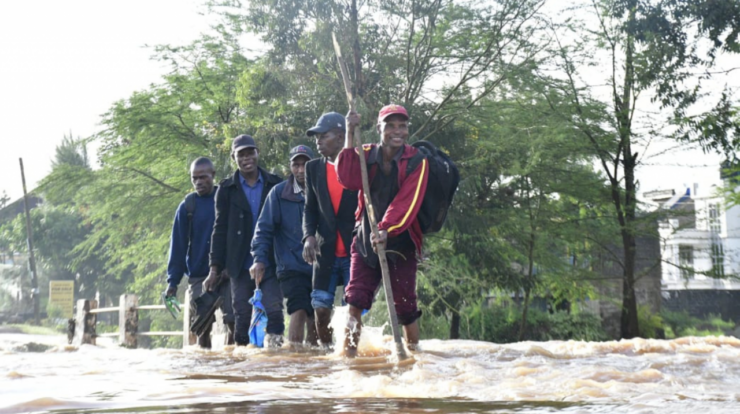
Kenya nairobi flooding – As Kenya’s Nairobi endures relentless flooding, this analysis delves into the causes, consequences, and strategies to address this escalating crisis, providing insights through the lens of Katadata.co.id.
Flooding in Nairobi has become a persistent challenge, leaving a trail of destruction in its wake. Heavy rainfall, inadequate drainage systems, and unplanned urbanization have converged to create a perfect storm, exacerbating the city’s vulnerability to flooding.
Overview of Flooding in Kenya’s Nairobi City

Nairobi, the capital and largest city of Kenya, is frequently plagued by flooding during the rainy seasons. These floods pose significant challenges to the city’s infrastructure, economy, and overall well-being of its residents.
The frequency and severity of flooding in Nairobi have increased in recent years due to a combination of factors, including heavy rainfall, poor drainage systems, urbanization, and land-use changes.
The impact of flooding on Nairobi’s infrastructure is substantial, often damaging roads, bridges, and buildings. The economic consequences are also significant, as businesses are disrupted, goods are damaged, and transportation is hindered.
Contributing Factors to Flooding
Heavy rainfall is a primary contributor to flooding in Nairobi. The city experiences intense downpours during the rainy seasons, which can overwhelm the existing drainage systems.
Poor drainage systems are another major factor exacerbating flooding. Many parts of Nairobi have inadequate or poorly maintained drainage channels, which fail to effectively channel rainwater away from populated areas.
Urbanization and land-use changes have also played a role in altering flooding patterns in Nairobi. As the city expands, natural drainage paths have been disrupted, leading to increased runoff and flooding.
Other factors contributing to flooding in Nairobi include deforestation, which reduces the capacity of the soil to absorb rainwater, and improper waste disposal practices, which can block drainage channels.
Consequences of Flooding, Kenya nairobi flooding
The consequences of flooding in Nairobi are both immediate and long-term. In the immediate aftermath, flooding can cause displacement, damage to property, and disruption of livelihoods.
Flooding also poses significant health risks, as it can lead to the spread of waterborne diseases and respiratory infections. Standing water can become breeding grounds for mosquitoes, increasing the risk of malaria and dengue fever.
The long-term consequences of flooding include damage to infrastructure, which can hamper economic growth and development. Flooding can also lead to soil erosion and contamination, which can have negative impacts on agriculture and water resources.
Mitigation and Adaptation Strategies
There are a number of measures that can be taken to mitigate flooding in Nairobi. These include improving drainage systems, implementing flood warning systems, and promoting sustainable land-use practices.
Green infrastructure, such as parks and wetlands, can also be utilized to absorb rainwater and reduce runoff. Rainwater harvesting systems can be implemented to capture and store rainwater for later use.
It is crucial to invest in flood mitigation and adaptation strategies to protect Nairobi from the adverse effects of flooding. By working together, stakeholders can develop and implement effective solutions to reduce the risks and impacts of flooding.
Role of Stakeholders in Flood Management
Effective flood management in Nairobi requires the involvement of various stakeholders, including government agencies, non-governmental organizations, and community members.
Government agencies have the primary responsibility for developing and implementing flood management policies and strategies. They also play a crucial role in coordinating emergency response and recovery efforts.
Non-governmental organizations can provide support by raising awareness, conducting research, and implementing community-based flood mitigation projects.
Community members can contribute to flood management by adopting responsible waste disposal practices, participating in flood preparedness and response activities, and advocating for effective flood management policies.
Final Review: Kenya Nairobi Flooding

Addressing Nairobi’s flooding crisis requires a multifaceted approach that combines infrastructure improvements, sustainable land-use planning, and community engagement. By harnessing innovation and collaboration, the city can mitigate the impacts of flooding, protect its residents, and pave the way for a more resilient future.
Detailed FAQs
What are the primary causes of flooding in Nairobi?
Heavy rainfall, poor drainage systems, and unplanned urbanization are the main contributing factors.
How does flooding impact Nairobi’s residents?
Flooding poses health risks, displaces people, damages property, and disrupts livelihoods.
What measures are being taken to mitigate flooding in Nairobi?
Infrastructure improvements, sustainable land-use planning, and community engagement are key strategies being implemented.





